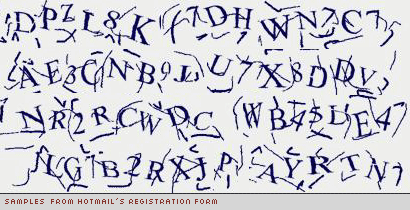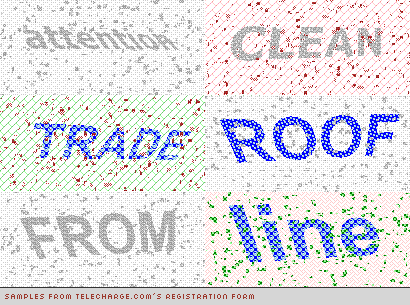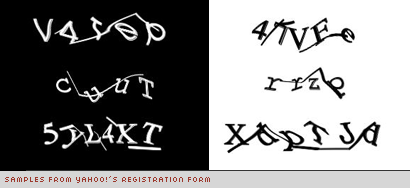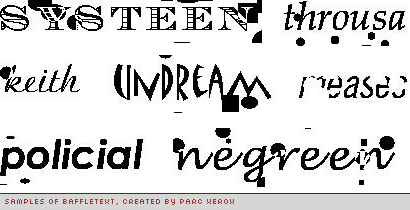Standing avidly in two-thousand-five and reminiscing fondly on typography — you too reminisce on typography from time to time, no? — the deconstructive days of yore seem far behind, even possibly, as Steve Heller said, appear as a “blip in the continuum of graphic design history”. A loud blip, but a blip now quieted by trends based on the reappraisal of wood type,Victorian letterforms and dingbats as well as a global bent towards bright and bold sans and large and elegant serifs. Deformed, scratched and rogue layouts and typography rarely elicit excitement in the new millennium — unless coming from Martin Venezky. Grunge fonts are now bottom-sellers compared to fanciful scripts and comprehensive type families. Its major exponents — Ed Fella, Neville Brody, Jeffrey Keedy, Katherine McCoy, April Greiman to name a few — have not titillated our sensitive retinae in some time. Yet, deconstructed typography is alive and well and… you, nor I, would never guess it: Functional.

During the day it is common to find yourself filling online forms for a variety of online errands: buying a book on Amazon.com, ordering theatre or movie tickets, paying utility bills or signing up for a gym you will never attend. With the advent of the evil spambot — software programs that perform repetitive functions capable of indexing e-mail addresses and information as well as promoting Viagra and poker on open-ended blogs and forums — has prompted more and more web sites to require entering verification codes at the end of a form. Basically, verification of your belonging to the human race. Most come in the form of loosely stretched and oddly letterspaced words, others, in more intricately deformed, rearranged and obscured random words and letters, and, like everything else on the internet, they come with a catchy title: CAPTCHAs.

A CAPTCHA, which stands for “Completely Automated Public Turing test to tell Computers and Humans Apart” is a really simple test that, presumably, any human can pass and determine that it is in fact a human with good intentions and not an automated computer with bad intentions submitting a form. CAPTCHAs may seem fairly new, but they have been used since 1997 when Altavista faced the problem of random web sites submitting their URL for its search engine. In 2000, Yahoo! contacted researchers at Carnegie Mellon University after bots invaded their chat rooms. Luis von Ahn, Manuel Blum, and Nicholas J. Hopper of CMU, and John Langford of IBM developed the first self-labeled CAPTCHA, called GIMPY, which required the user to enter three of seven random selected words — from a dictionary of 850 words — distorted and layered on a colorful background.

For Yahoo! CMU Professors implemented a simpler version, called EZ-GIMPY which selected a random word, distorted it slightly, placed it on a busy background and asked the user to identify the word. These original CAPTCHAS were simple and easy to solve — perhaps too simple. Greg Mori and Jitendra Malik of UC Berkeley’s Computer Vision Group found an automated procedure to decrypt EZ-GIMPY’s CAPTCHAs. Here, they describe the process through which they reconstruct the deconstructed. Regardless of EZ-GIMPY’s hackability, the method is still in use by Yahoo! and many other web sites. However, today’s CAPTCHAs are visually harder to decipher by bots and sometimes even humans. (If you are wondering how visually-impaired people handle CAPTCHAs, there are spoken CAPTCHAs — good luck with that).
Another iteration of CAPTCHA research and development was conducted by Xerox’s PARC (Palo Alto Research Center) where two different CAPTCHAs were created. The first, BaffleText, generated random nonsense words rather than real words people can understand and it also took more liberty in the deconstruction of the words finding comfort in Gestalt psychology and trusting that the brain would be able to fill in the gaps. The second, Pessimal Print, took “a word (from a fixed list), a typeface (from a fixed list), and a set of image-degradation parameters (from fixed ranges)” to generate its puzzles. These two applications prove that even though we read best what we read most we read pretty good when we put in a little effort.

CAPTCHAs pass unacknowledged amongst most users, they are simply one last step after hitting the auto-fill button in a browser. During the past years they have become more complex in keeping with evil-doers’ ability to crack them and in doing so are pushing the boundaries of readability just like David Carson did… does. However, there is no theory, no pretense, no old guard clamoring the misuse of type, no posters to be hanged. In CAPTCHAs, deconstructive typography has found its place. Blip.







interesting!
The idea of post-structuralism and specifically deconstructivism and how they relate to the graphic design object (type, page, book, etc..) is what i am planning to explore for my thesis (i am pretty sure anyway) - so i find this article to be especially on-topic for me. Now then, i might be completely wrong in my forthcoming statements, and i certainly mean this will all due respect Armin, but i think i want to disagree with your use of the word 'deconstruction' in this context - i do not think these are examples of deconstructed typography, i think these are more degraded or possibly even decayed typography.
i would consider a deconstruction of typography to (as an example) oppose that which is the primary purpose of type: to communicate. these examples clearly do communicate; e.g. they are readable and in normal conventional english - and they work the same way type works - (somewhat) regular forms combined into groups that then formulate words that have meaning. (even the yahoo! type codes do this - its just that the word happens to be a bunch of random letters) These examples are certainly altered (some highly altered) and often degraded, but not really deconstructed.
now, i most certainly do not have the answer for what is deconstructed type (in fact, i am not sure it would even be a useful answer at that) but after my thesis i will let you know if i figure anything out.
one thing i do find particularly enjoyable about these is the almost Dada-like nature of the Yahoo! CAPTCHAs - they really do their own kind of private tribal electronic dance in their little electronic boxes.
On Jan.26.2005 at 11:51 PM